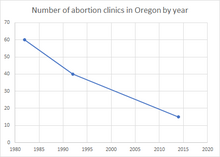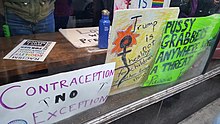Abortion in Oregon is legal at all stages of pregnancy.[1][2]
The number of abortion clinics in Oregon has declined over the years, with sixty in 1982, forty in 1992, and fifteen in 2014. There were 8,231 legal abortions in 2014, and 8,610 in 2015.
History[edit]
The parents of Becky Bell worked with the Feminist Majority Foundation in the 1990s, which credited them with helping to turn public opinion against a parental-notification law in Oregon.[3]
Legislative history[edit]
In the late 1960s, Arkansas, California, Colorado, Georgia, Maryland, New Mexico, North Carolina, and Oregon made reforms to their abortion laws, with most of these states providing more detailed medical guidance on when therapeutic abortions could be performed.[4]
In 1962, the American Law Institute published their model penal code, as it applied to abortions, with three circumstances where they believed a physician could justifiably perform an abortion: "If ... there is substantial risk that the continuance of the pregnancy would gravely impair the physical or mental health of the mother, or that the child would be born with grave physical or mental defect, or that the pregnancy resulted from rape, incest, or other felonious intercourse." Versions of this model were passed into law in many states during the late 1960s and early 1970s. Oregon was an exception in that they chose to model their law after the British Abortion Act of 1967.[5] State law as of 1971 required that any woman getting a legal abortion in the state needed to be a resident for some specific period between 30 and 90 days.[5]
As of 2017, California, Oregon, Montana, Vermont, and New Hampshire allow qualified non-physician health professionals, such as physician assistants, nurse practitioners, and certified nurse midwives, to do first-trimester aspiration abortions and to prescribe drugs for medical abortions.[6] In Oregon the Reproductive Health Equity Act was passed in 2017, which required health insurance to offer abortion coverage and to absorb most of the costs for the procedure, instead of passing them along to women.[7][8][9] As of August 2018, the state had a law to protect the right to have an abortion.[10][7] As of May 2019, Oregon was one of only a few states in the nation that had no gestational age limit on abortion, and the only one with no restrictions at all.[7]
Ballot box history[edit]
There was a ballot box measure in 2018 that sought to limit the ability of the state to use public funds to pay for abortions. This was rejected by voters.[7][11]
Judicial history[edit]
The US Supreme Court's decision in 1973's Roe v. Wade ruling meant the state could no longer regulate abortion in the first trimester.[4] However, the Supreme Court overturned Roe v. Wade in Dobbs v. Jackson Women's Health Organization, No. 19-1392, 597 U.S. ___ (2022) later in 2022.[12][13]
Clinic history[edit]

Between 1982 and 1992, the number of abortion clinics in the state decreased by twenty, going from sixty in 1982 to forty in 1992.[14] In 2014, there were fifteen abortion clinics in the state.[15] In 2014, 78% of the counties in the state did not have an abortion clinic. That year, 30% of women in the state aged 15–44 lived in a county without an abortion clinic.[10] In 2017, there were 12 Planned Parenthood clinics, of which 8 offered abortion services, in a state with a population of 911,617 women aged 15–49. That year, 30% of women in the state aged 15–44 lived in a county without an abortion clinic.[16]
Statistics[edit]
In the period between 1972 and 1974, there were no recorded illegal abortion deaths in the state.[17] In 1990, 332,000 women in the state faced the risk of an unintended pregnancy.[14] In 2013, among white women aged 15–19, there were 760 abortions, 60 abortions for black women aged 15–19, 140 abortions for Hispanic women aged 15–19, and 70 abortions for women of all other races.[18] In 2014, 63% of adults said in a poll by the Pew Research Center that abortion should be legal in all or most cases.[19] In 2017, the state had an infant mortality rate of 5.4 deaths per 1,000 live births.[20]
| Census division and state | Number | Rate | % change 1992–1996 | ||||
|---|---|---|---|---|---|---|---|
| 1992 | 1995 | 1996 | 1992 | 1995 | 1996 | ||
| US Total | 1,528,930 | 1,363,690 | 1,365,730 | 25.9 | 22.9 | 22.9 | –12 |
| Pacific | 368,040 | 290,520 | 288,190 | 38.7 | 30.5 | 30.1 | –22 |
| Alaska | 2,370 | 1,990 | 2,040 | 16.5 | 14.2 | 14.6 | –11 |
| California | 304,230 | 240,240 | 237,830 | 42.1 | 33.4 | 33 | –22 |
| Hawaii | 12,190 | 7,510 | 6,930 | 46 | 29.3 | 27.3 | –41 |
| Oregon | 16,060 | 15,590 | 15,050 | 23.9 | 22.6 | 21.6 | –10 |
| Washington | 33,190 | 25,190 | 26,340 | 27.7 | 20.2 | 20.9 | –24 |
| Location | Residence | Occurrence | % obtained by
out-of-state residents |
Year | Ref | ||||
|---|---|---|---|---|---|---|---|---|---|
| No. | Rate^ | Ratio^^ | No. | Rate^ | Ratio^^ | ||||
| Oregon | 7,683 | 9.9 | 169 | 8,231 | 10.6 | 181 | 9.6 | 2014 | [22] |
| Oregon | 7,847 | 10 | 172 | 8,610 | 10.9 | 189 | 11.2 | 2015 | [23] |
| Oregon | 8,230 | 10.3 | 181 | 8,942 | 11.2 | 196 | 10.6 | 2016 | [24] |
| ^number of abortions per 1,000 women aged 15–44; ^^number of abortions per 1,000 live births | |||||||||
Abortion financing[edit]
Seventeen US states, including Oregon, used their own funds to cover all or most "medically necessary" abortions sought by low-income women under Medicaid, thirteen of which are required by State court orders to do so.[25] In 2010, the state had 3,427 publicly funded abortions, of which none were federally funded, and all were state funded.[26]
Abortion rights views and activities[edit]

Protests[edit]
Women from the state participated in marches supporting abortion rights as part of a #StoptheBans movement in May 2019.[27]
Following the overturn of Roe v. Wade on June 24, 2022, at least 2,000 abortion rights protesters gathered for a protest in Downtown Portland, Oregon.[28] 10 people were arrested at a June 24 protest in Eugene.[29]
Anti-abortion views and activities[edit]
Violence[edit]
The first clinic arson occurred in Oregon in March 1976 and the first bombing occurred in February 1978 in Ohio.[30][31] The attack took place at a Planned Parenthood clinic in Eugene and was committed by an individual.[31]
Rachelle "Shelley" Shannon attempted to set fires at abortion clinics in Oregon, California, Idaho and Nevada during the late 1980s and early 1990s and eventually pleaded guilty for these cases of arson. In 1993, she was found guilty of attempted murder of George Tiller in 1993 at his Wichita, Kansas clinic.[31]
On November 23, 2021, Devin Kruse, 27, destroyed several windows and security cameras at a Planned Parenthood in Grants Pass, Oregon. He pleaded guilty to two counts of violating the federal Freedom of Access to Clinic Entrances Act.[32]
References[edit]
- ^ "Are there *any* states working to protect abortion rights?". Well+Good. 2019-05-17. Retrieved May 25, 2019.
- ^ Abortion policy in the absence of Roe, Guttmacher Institute, 1 September 2021.
- ^ Lewin, Tamar (October 27, 1991). "In Debate on Abortion, 2 Girls Make It Real". The New York Times. p. 1.
- ^ a b Buell, Samuel (1991-01-01). "Criminal Abortion Revisited". New York University Law Review. 66 (6): 1774–1831. PMID 11652642.
- ^ a b Tyler, C. W. (1983). "The public health implications of abortion". Annual Review of Public Health. 4: 223–258. doi:10.1146/annurev.pu.04.050183.001255. ISSN 0163-7525. PMID 6860439.
- ^ "Study: Abortions Are Safe When Performed By Nurse Practitioners, Physician Assistants, Certified Nurse Midwives". 17 January 2013. Retrieved 25 January 2017.
- ^ a b c d "Are there *any* states working to protect abortion rights?". Well+Good. 2019-05-17. Retrieved May 25, 2019.
- ^ "HB3391". olis.leg.state.or.us. 2017. Archived from the original (PDF) on 2020-10-20. Retrieved 2019-07-06.
- ^ "Oregon Health Authority: Reproductive Health Equity Act: Reproductive and Sexual Health: State of Oregon". www.oregon.gov. Retrieved May 25, 2019.
- ^ a b Panetta, Grace; lee, Samantha (2018-08-04). "This is what could happen if Roe v. Wade fell". Business Insider (in Spanish). Archived from the original on 2019-05-24. Retrieved 2019-05-24.
- ^ Harbarger, Molly (2018-11-07). "Anti-abortion Measure 106 defeated in 2018 Oregon election". oregonlive.com. Retrieved May 25, 2019.
- ^ de Vogue, Arinne (June 24, 2022). "Supreme Court overturns Roe v. Wade". CNN. Archived from the original on June 24, 2022. Retrieved June 24, 2022.
- ^ Howe, Amy (June 24, 2022). "Supreme Court overturns constitutional right to abortion". SCOTUSblog. Archived from the original on June 24, 2022. Retrieved June 24, 2022.
- ^ a b Arndorfer, Elizabeth; Michael, Jodi; Moskowitz, Laura; Grant, Juli A.; Siebel, Liza (December 1998). A State-By-State Review of Abortion and Reproductive Rights. Diane Publishing. ISBN 9780788174810.
- ^ Gould, Rebecca Harrington, Skye. "The number of abortion clinics in the US has plunged in the last decade — here's how many are in each state". Business Insider. Retrieved 2019-05-23.
{{cite web}}: CS1 maint: multiple names: authors list (link) - ^ "Here's Where Women Have Less Access to Planned Parenthood". Retrieved 2019-05-23.
- ^ Cates, Willard; Rochat, Roger (March 1976). "Illegal Abortions in the United States: 1972–1974". Family Planning Perspectives. 8 (2): 86–92. doi:10.2307/2133995. JSTOR 2133995. PMID 1269687.
- ^ "No. of abortions among women aged 15–19, by state of residence, 2013 by racial group". Guttmacher Data Center. Retrieved 2019-05-24.
- ^ "Views about abortion by state - Religion in America: U.S. Religious Data, Demographics and Statistics". Pew Research Center. Retrieved 2019-05-23.
- ^ "States pushing abortion bans have highest infant mortality rates". NBC News. 24 May 2019. Retrieved May 25, 2019.
- ^ Henshaw, Stanley K. (2005-06-15). "Abortion Incidence and Services in the United States, 1995-1996". Perspectives on Sexual and Reproductive Health. 30: 263–270. Retrieved 2019-06-02.
- ^ Jatlaoui, Tara C. (2017). "Abortion Surveillance — United States, 2014". MMWR. Surveillance Summaries. 66 (24): 1–48. doi:10.15585/mmwr.ss6624a1. ISSN 1546-0738. PMC 6289084. PMID 29166366.
- ^ Jatlaoui, Tara C. (2018). "Abortion Surveillance — United States, 2015". MMWR. Surveillance Summaries. 67 (13): 1–45. doi:10.15585/mmwr.ss6713a1. ISSN 1546-0738. PMC 6289084. PMID 30462632.
- ^ Jatlaoui, Tara C. (2019). "Abortion Surveillance — United States, 2016". MMWR. Surveillance Summaries. 68 (11): 1–41. doi:10.15585/mmwr.ss6811a1. ISSN 1546-0738. PMC 6289084. PMID 31774741.
- ^ Francis Roberta W. "Frequently Asked Questions". Equal Rights Amendment. Alice Paul Institute. Archived from the original on 2009-04-17. Retrieved 2009-09-13.
- ^ "Guttmacher Data Center". data.guttmacher.org. Retrieved 2019-05-24.
- ^ Bacon, John. "Abortion rights supporters' voices thunder at #StopTheBans rallies across the nation". USA Today. Retrieved May 25, 2019.
- ^ Macuk, Anthony (June 24, 2022). "Thousands gather in downtown Portland to protest the overturning of Roe". KGW NBC 8.
- ^ Campbell, Sam (June 25, 2022). "10 arrested in Eugene protest of SCOTUS Roe v Wade overturn". KOIN CBS 6. Retrieved June 26, 2022.
- ^ National Abortion Federation. (2007). "Arsons and Bombings "National Abortion Federation: Clinic Violence: Arsons and Bombings". Archived from the original on September 26, 2011. Retrieved May 22, 2019.." Retrieved February 10, 2007.
- ^ a b c Jacobson, Mireille; Royer, Heather (December 2010). "Aftershocks: The Impact of Clinic Violence on Abortion Services". American Economic Journal: Applied Economics. 3: 189–223. doi:10.1257/app.3.1.189.
- ^ "Man pleads guilty to breaking windows at Planned Parenthood". Associated Press. September 20, 2022. Retrieved September 20, 2022.